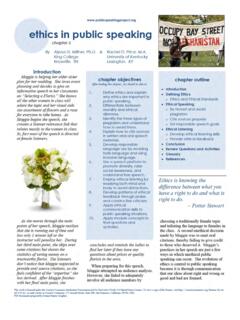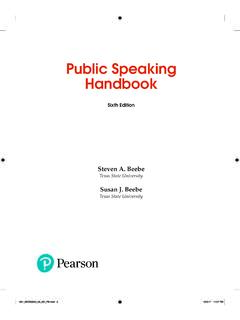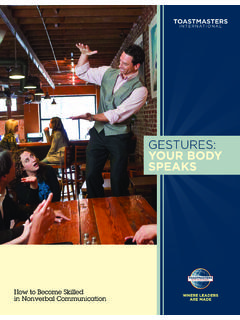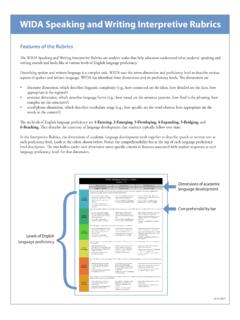Transcription of Introduction to Public Speaking - HTML in 10 Simple Steps ...
1 2013 This work is licensed under the Creative Commons Attribution-Noncommercial-No Derivative Works United States License. To view a copy of this license, visit or send a letter to Creative Commons, 171 Second Street, Suite 300, San Francisco, California, 94105, USA. PDF documents prepared by Lisa Schreiber. Document layout by Donna Painter Graphics. Public Speaking : The Virtual Text Introduction Humans ability to communicate using formalized systems of language sets us apart from other living creatures on the Earth. Whether these language conventions make us superior to other creatures is debatable, but there is no question that overall, the most successful and most powerful people over the centuries have mastered the ability to communicate effectively.
2 In fact, the skill of Speaking is so important that it has been formally taught for thousands of years (see Chapter 2 The Origins of Public Speaking by DeCaro). The ironic feature of Public Speaking is that while we recognize that it is an important skill to have, many of us do not like or want to give speeches. You may be reading this book because it was assigned to you in a class, or you may be reading it because you have to give a speech in your personal or professional life. If you are reading this book because you like Public Speaking or you have a burning desire to learn more about it, you re in the minority.
3 The good news about Public Speaking is that although it may not be on the top of the list of our favorite activities, anyone can learn to give effective presentations. You don t have to look like a Hollywood star and you don t have to use fancy words to be a successful speaker. What is important is that the audience understands you and remembers what you have to say. By learning and using the techniques provided in this book, you will discover how to create engaging speeches and present them using your own delivery style. The purpose of this chapter is to familiarize readers with the basic concepts of communication and Public Speaking .
4 The chapter begins with a description of the personal, professional, and Public benefits of learning more about Public Speaking . Then the transactional model of communication is introduced along with the fundamental components of the communication process. Next, readers will learn about different types of speeches and the occasions for which they would be presented. The chapter ends with an overview of eleven primary Public Speaking competencies. Wherever I go meeting the spreading a message of human values, spreading a message of harmony, is the most important thing.
5 ~Dalai Lama Introduction to Public Speaking chapter 1 By Lisa Schreiber, and Morgan Hartranft Millersville University, Millersville, PA Public Speaking : The Virtual Text chapter objectives After reading this chapter, you should be able to: 1. Articulate at least three reasons why Public Speaking skills are important. 2. Describe the difference between the linear and the transactional model of communication. 3. List, define, and give an example of each of the components of communication. 4. Differentiate between the major types of speeches 5.
6 Identify the eleven core Public Speaking competencies. 6. Apply chapter concepts in final questions and activities. chapter outline Introduction Benefits of Public Speaking o Personal o Professional o Public Models of Communication o Linear o Transactional Elements of the Communication Process o Encoding and Decoding o Communicator o Message o Channel o Noise o Worldview o Context Types of Speeches Speaking Competencies o Useful Topic o Engaging Introduction o Clear Organization o Well-Supported Ideas o Closure in Conclusion o Clear and Vivid Language o Suitable Vocal Expression o Corresponding Nonverbals o Adapted to the Audience o Adept Use of
7 Visual Aids o Convincing Persuasion Conclusion Review Questions and Activities Glossary References Chapter 1 Introduction to Public Speaking 1-2 benefits of Public Speaking According to the Association of American Colleges and Universities, there are a core set of skills that are necessary both for a globally engaged democracy and for a dynamic-innovation fueled economy (Rhodes, 2010, p. 10). In the category of Intellectual and practical skills Public Speaking is listed as one of these core skills. This is not particularly surprising given that communication skills are critical for intellectual development, career trajectory, and civic engagement.
8 Public Speaking is universally applicable to all types of majors and occupations and is seen by employers as a critical employability skill for job seekers (Rockler-Gladen, 2009; Department of Labor, 2000). No matter what your ambitions and interests are, developing Speaking skills will benefit your personal, professional, and Public life. personal People don t just give presentations on the job and in classes. At times we are called upon to give speeches in our personal lives. It may be for a special event, such as a toast at a wedding. We may be asked to give a eulogy at a funeral for a friend or loved one.
9 As a part of volunteer work, one may have to introduce a guest speaker at an event or present or accept an award for service. Chapter 17, Special Occasion Speaking by Scholl will help you to prepare for these brief but important speeches. Developing the skill to give these types of speeches can help us to fulfill essential roles in our family and community. Another great personal benefit of Public Speaking is that it builds self- confidence . It s no surprise that Speaking in Public is scary, but by engaging in the activity you will build self- confidence through the experience.
10 Chapter 11, Speaking with confidence by Grapsy ( in this book) will give you advice on how to minimize speech apprehension, and the advice can be used in many other social situations as well. Action is a great restorer and builder of confidence . Inaction is not only the result, but the cause, of fear. Perhaps the action you take will be successful; perhaps different action or adjustments will have to follow. But any action is better than no action at all. ~ Norman Vincent Peale professional TV announcers, teachers, lawyers, and entertainers must be able to speak well, but most other professions require or at the very least can benefit from the skills found in Public Speaking .









